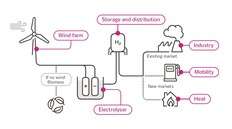- RWE and innogy are conducting a feasibility study for a 100 MW green hydrogen plant in Groningen.
- The study will assess the plant's feasibility in collaboration with partners and authorities, with findings expected in autumn.
- Westereems Wind Farm will supply green electricity for hydrogen production.
- The Eemshaven power station will provide demineralised water and biomass electricity for hydrogen production.

Feasibility Study for Green Hydrogen Plant
RWE and innogy are jointly examining the large-scale production of green hydrogen in the Province of Groningen. They have initiated a feasibility study to build a hydrogen plant of up to 100 MW at RWE's Eemshaven power station, leveraging green electricity from innogy’s Westereems Wind Farm.
Project Goals and Collaboration
The project aims to use wind energy to produce significant volumes of green hydrogen, contributing to CO2 reduction targets in transport, heat supply, and industry. The companies will collaborate with other partners in the chain and regional and national authorities to assess the feasibility of the hydrogen plant. Initial findings are expected in the autumn.
Strategic Focus on Renewables
RWE's corporate strategy emphasizes renewables and storage technologies. Projects like this in Groningen and GET H2 in Lingen support this strategy through concrete research and development initiatives. The Westereems Wind Farm, one of the largest onshore wind farms in the Netherlands, will play a crucial role in this demonstration project.
Technical and Regulatory Considerations
The Eemshaven power station will provide demineralised water for the hydrogen production process, and biomass electricity can supplement production when wind energy is unavailable. The project also requires adjustments to the regulatory framework to become competitive under current regulations.
Impact on Energy Transition
Green hydrogen, produced through electrolysis using renewable energies, can significantly reduce CO2 emissions beyond the electricity sector. It holds potential for decarbonizing energy-intensive industries like steel, chemicals, and cement, and could serve as a sustainable fuel for transport and residential heating.

